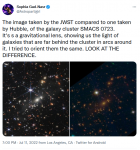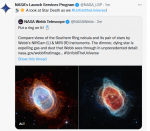You are using an out of date browser. It may not display this or other websites correctly.
You should upgrade or use an alternative browser.
You should upgrade or use an alternative browser.
SCI One of first images taken by James Webb Space Telescope
- Thread starter Mzkitty
- Start date
That telescope is the successor to the Hubble.
Mzkitty
I give up.
The Hammer
Has No Life - Lives on TB
Previewed by POTUS?
Not sure why they thought that was relevant...

But definitely beyond cool!
Lone_Hawk
Resident Spook
Earth Changes, Solar and Celestial Events
Here we discuss global climate and weather issues, as well as solar activity, and various other celestial events and issues. Note that this room is dedicated to the more "mainstream" issues. The more fringe-type material should go in UNEX.
summer-texan
Senior Member
millions of galaxy's with millions of solar systems.
I still have friends that say no way is there life anywhere else than earth.
I still have friends that say no way is there life anywhere else than earth.
Doc1
Has No Life - Lives on TB
millions of galaxy's with millions of solar systems.
I still have friends that say no way is there life anywhere else than earth.
Also consider that the Earth is a small planet, orbiting a small star, in a small galaxy! Perspective is important.
Best
Doc
MinnesotaSmith
Membership Revoked
Related:You can't tell me, with all that is out there, that we are the only life. Absolutely stunning image.

Are We Alone in the Universe? Revisiting the Drake Equation - NASA Science
A speculative study finds a new answer to the question: will we find intelligent alien life?

Two researchers have revised the Drake equation, a mathematical formula for the probability of finding life or advanced civilizations in the universe.
"Are humans unique and alone in the vast universe? This question--summed up in the famous Drake equation--has for a half-century been one of the most intractable and uncertain in science.
But a new paper shows that the recent discoveries of exoplanets combined with a broader approach to the question makes it possible to assign a new empirically valid probability to whether any other advanced technological civilizations have ever existed.
And it shows that unless the odds of advanced life evolving on a habitable planet are astonishingly low, then human kind is not the universe’s first technological, or advanced, civilization.
The paper, published in Astrobiology, also shows for the first time just what “pessimism” or “optimism” mean when it comes to estimating the likelihood of advanced extraterrestrial life.
“The question of whether advanced civilizations exist elsewhere in the universe has always been vexed with three large uncertainties in the Drake equation,” said Adam Frank, professor of physics and astronomy at the University of Rochester and co-author of the paper. “We’ve known for a long time approximately how many stars exist. We didn’t know how many of those stars had planets that could potentially harbor life, how often life might evolve and lead to intelligent beings, and how long any civilizations might last before becoming extinct.”
“Of course, we have no idea how likely it is that an intelligent technological species will evolve on a given habitable planet,” says Frank. But using our method we can tell exactly how low that probability would have to be for us to be the ONLY civilization the Universe has produced. We call that the pessimism line. If the actual probability is greater than the pessimism line, then a technological species and civilization has likely happened before.”
Using this approach, Frank and Sullivan calculate how unlikely advanced life must be if there has never been another example among the universe’s ten billion trillion stars, or even among our own Milky Way galaxy’s hundred billion.
The result? By applying the new exoplanet data to the universe’s 2 x 10 to the 22nd power stars, Frank and Sullivan find that human civilization is likely to be unique in the cosmos only if the odds of a civilization developing on a habitable planet are less than about one in 10 billion trillion, or one part in 10 to the 22nd power.Rather than asking how many civilizations may exist now, we ask ‘Are we the only technological species that has ever arisen?'
- Woodruff Sullivan, University of Washington
“One in 10 billion trillion is incredibly small,” says Frank. “To me, this implies that other intelligent, technology producing species very likely have evolved before us. Think of it this way. Before our result you’d be considered a pessimist if you imagined the probability of evolving a civilization on a habitable planet were, say, one in a trillion. But even that guess, one chance in a trillion, implies that what has happened here on Earth with humanity has in fact happened about a 10 billion other times over cosmic history!”
For smaller volumes the numbers are less extreme. For example, another technological species likely has evolved on a habitable planet in our own Milky Way galaxy if the odds against it evolving on any one habitable planet are better than one chance in 60 billion.
But if those numbers seem to give ammunition to the “optimists” about the existence of alien civilizations, Sullivan points out that the full Drake equation—which calculates the odds that other civilizations are around today—may give solace to the pessimists.
“Thanks to NASA's Kepler satellite and other searches, we now know that roughly one-fifth of stars have planets in “habitable zones,” where temperatures could support life as we know it. So one of the three big uncertainties has now been constrained.”
This artist’s conception of a planetary lineup shows habitable zone planets with similarities to Earth: from left, Kepler-22b, Kepler-69c, Kepler-452b, Kepler-62f and Kepler-186f. Last in line is Earth itself. Credit: NASA/JPL-Caltech
Frank said that the third big question--how long civilizations might survive--is still completely unknown. “The fact that humans have had rudimentary technology for roughly ten thousand years doesn’t really tell us if other societies would last that long or perhaps much longer,” he explained.
But Frank and his coauthor, Woodruff Sullivan of the astronomy department and astrobiology program at the University of Washington, found they could eliminate that term altogether by simply expanding the question.
“Rather than asking how many civilizations may exist now, we ask ‘Are we the only technological species that has ever arisen?" said Sullivan. “This shifted focus eliminates the uncertainty of the civilization lifetime question and allows us to address what we call the ‘cosmic archaeological question’—how often in the history of the universe has life evolved to an advanced state?”
That still leaves huge uncertainties in calculating the probability for advanced life to evolve on habitable planets. It's here that Frank and Sullivan flip the question around. Rather than guessing at the odds of advanced life developing, they calculate the odds against it occurring in order for humanity to be the only advanced civilization in the entire history of the observable universe. With that, Frank and Sullivan then calculated the line between a Universe where humanity has been the sole experiment in civilization and one where others have come before us.
The Drake equation, a mathematical formula for the probability of finding life or advanced civilizations in the universe.
In 1961, astrophysicist Frank Drake developed an equation to estimate the number of advanced civilizations likely to exist in the Milky Way galaxy. The Drake equation (top row) has proven to be a durable framework for research, and space technology has advanced scientists' knowledge of several variables. But it is impossible to do anything more than guess at variables such as L, the probably longevity of other advanced civilizations.
In new research, Adam Frank and Woodruff Sullivan offer a new equation (bottom row) to address a slightly different question: What is the number of advanced civilizations likely to have developed over the history of the observable universe? Frank and Sullivan's equation draws on Drake's, but eliminates the need for L.
Their argument hinges upon the recent discovery of how many planets exist and how many of those lie in what scientists call the “habitable zone” – planets in which liquid water, and therefore life, could exist. This allows Frank and Sullivan to define a number they call Nast. Nast is the product of N*, the total number of stars; fp, the fraction of those stars that form planets; and np, the average number of those planets in the habitable zones of their stars.
They then set out what they call the “Archaelogical-form” of the Drake equation, which defines A as the “number of technological species that have ever formed over the history of the observable Universe.”
Their equation, A=Nast*fbt, describes A as the product of Nast – the number of habitable planets in a given volume of the Universe – multiplied by fbt – the likelihood of a technological species arising on one of these planets. The volume considered could be, for example, the entire Universe, or just our Galaxy.
“The universe is more than 13 billion years old,” said Sullivan. “That means that even if there have been a thousand civilizations in our own galaxy, if they live only as long as we have been around—roughly ten thousand years—then all of them are likely already extinct. And others won’t evolve until we are long gone. For us to have much chance of success in finding another "contemporary" active technological civilization, on average they must last much longer than our present lifetime.”
“Given the vast distances between stars and the fixed speed of light we might never really be able to have a conversation with another civilization anyway,” said Frank. “If they were 20,000 light years away then every exchange would take 40,000 years to go back and forth.”
But, as Frank and Sullivan point out, even if there aren’t other civilizations in our galaxy to communicate with now, the new result still has a profound scientific and philosophical importance. “From a fundamental perspective the question is ‘has it ever happened anywhere before?’” said Frank. Our result is the first time anyone has been able to set any empirical answer for that question and it is astonishingly likely that we are not the only time and place that an advance civilization has evolved.”
According to Frank and Sullivan their result has a practical application as well. As humanity faces its crisis in sustainability and climate change we can wonder if other civilization-building species on other planets have gone through a similar bottleneck and made it to the other side. As Frank puts it “We don’t even know if it’s possible to have a high-tech civilization that lasts more than a few centuries.” With Frank and Sullivan’s new result, scientists can begin using everything they know about planets and climate to begin modeling the interactions of an energy-intensive species with their home world knowing that a large sample of such cases has already existed in the cosmos. “Our results imply that our evolution has not been unique and has probably happened many times before. The other cases are likely to include many energy intensive civilizations dealing with their feedbacks onto their planets as their civilizations grow. That means we can begin exploring the problem using simulations to get a sense of what leads to long lived civilizations and what doesn’t.”"
https://exoplanets.nasa.gov/alien-worlds/strange-new-worlds
WildDaisy
God has a plan, Trust it!
Previewed by POTUS?
Not sure why they thought that was relevant...
But definitely beyond cool!
Because he's the head Space Cadet of course. And from all his babbling, I'm sure he was head of the class
Something STRANGE on the photo - the star in the center (and a few other) have "rays" projecting out from them?
I could see this on a ground based scope - but in space they should only be showing up as a point of light - don't think it is lens flare - not sure - but does not look natural. Or could NASA have "touched up" the photos?
I could see this on a ground based scope - but in space they should only be showing up as a point of light - don't think it is lens flare - not sure - but does not look natural. Or could NASA have "touched up" the photos?
With the question of is there life in distant galaxies I'm sure there is, but we have no way to go there and find it.
As for other life in our own galaxy and again we have no way to travel to distant solar systems, right now the closest star is about three light years from us.
Voyager 1. sent into space in 1977 is on it's way to that star and 45 years later it's not even close to 1/8 of the way there.
As for other life in our own galaxy and again we have no way to travel to distant solar systems, right now the closest star is about three light years from us.
Voyager 1. sent into space in 1977 is on it's way to that star and 45 years later it's not even close to 1/8 of the way there.
kyrsyan
Has No Life - Lives on TB
Rays, iirc, are an effect of debris in between the item and the viewer causing distortion space is big and does not have an atmosphere, but it does have dust and other debris that could cause distortions.Something STRANGE on the photo - the star in the center (and a few other) have "rays" projecting out from them?
I could see this on a ground based scope - but in space they should only be showing up as a point of light - don't think it is lens flare - not sure - but does not look natural. Or could NASA have "touched up" the photos?
Add in that the scope has already taken damage to one of its reflector panels as well. And it is too far away for a repair mission.
Masterphreak
Veteran Member
Something STRANGE on the photo - the star in the center (and a few other) have "rays" projecting out from them?
I could see this on a ground based scope - but in space they should only be showing up as a point of light - don't think it is lens flare - not sure - but does not look natural. Or could NASA have "touched up" the photos?
These rays are caused by the hexagonal-shaped mirror sections.
Here is an article that explains it.
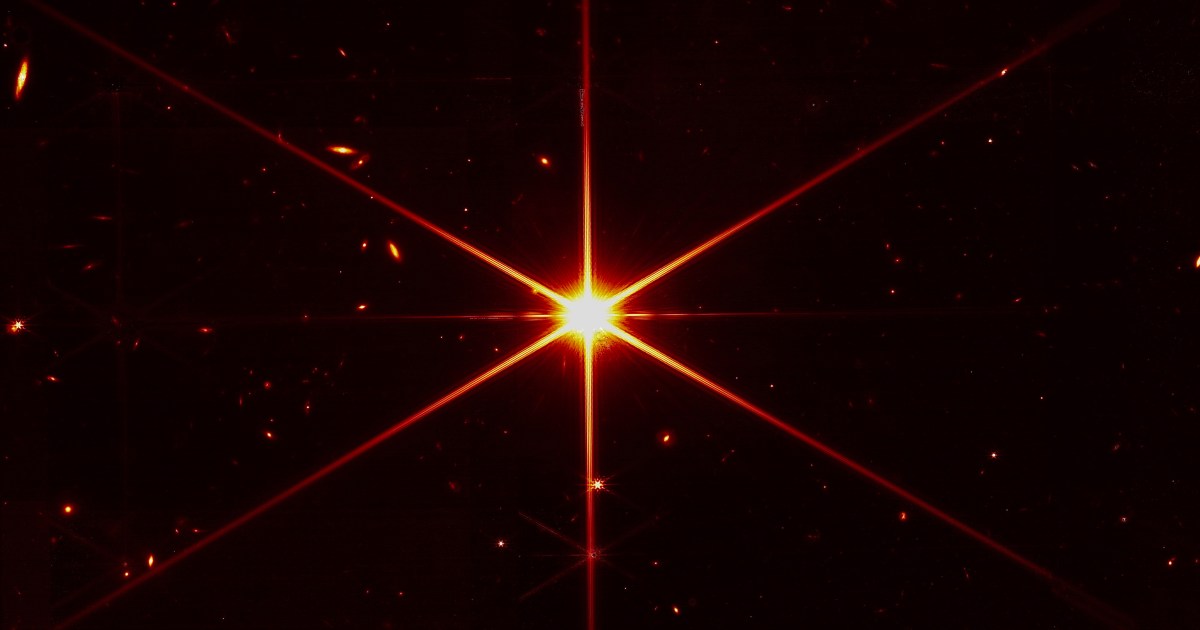
Where do James Webb's unique "spikes" come from?
When we started imaging the Universe with Hubble, every star had four "spikes" coming from it. Here's why Webb will have more.
Telescope Steve
Veteran Member
The spikes are diffraction caused by the 3 beams that support the secondary mirror. The edges of these beams cause the light to scatter off of them.Something STRANGE on the photo - the star in the center (and a few other) have "rays" projecting out from them?
I could see this on a ground based scope - but in space they should only be showing up as a point of light - don't think it is lens flare - not sure - but does not look natural. Or could NASA have "touched up" the photos?
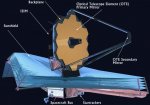
Yeah... they put it in front of his Pack n Play to lull him to sleep for his nap!Previewed by POTUS?
Not sure why they thought that was relevant...
But definitely beyond cool!
Summerthyme
end game
Veteran Member
Voyager 1 telemetry:With the question of is there life in distant galaxies I'm sure there is, but we have no way to go there and find it.
As for other life in our own galaxy and again we have no way to travel to distant solar systems, right now the closest star is about three light years from us.
Voyager 1. sent into space in 1977 is on it's way to that star and 45 years later it's not even close to 1/8 of the way there.
Hard to copy the site due to animation and counter of mission time.
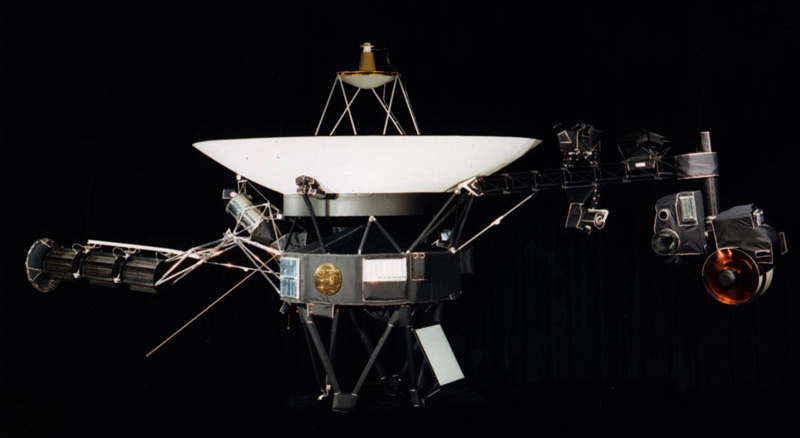
Voyager - Mission Status
voyager.jpl.nasa.gov
Actually Proxima Centauri is the closest at 4.24 light years equivalent to 5.88 trillion miles. Sadly Voyager is not even 1/9 of the way there and because of the power loss won't be able to keep it's instruments going for much longer.




